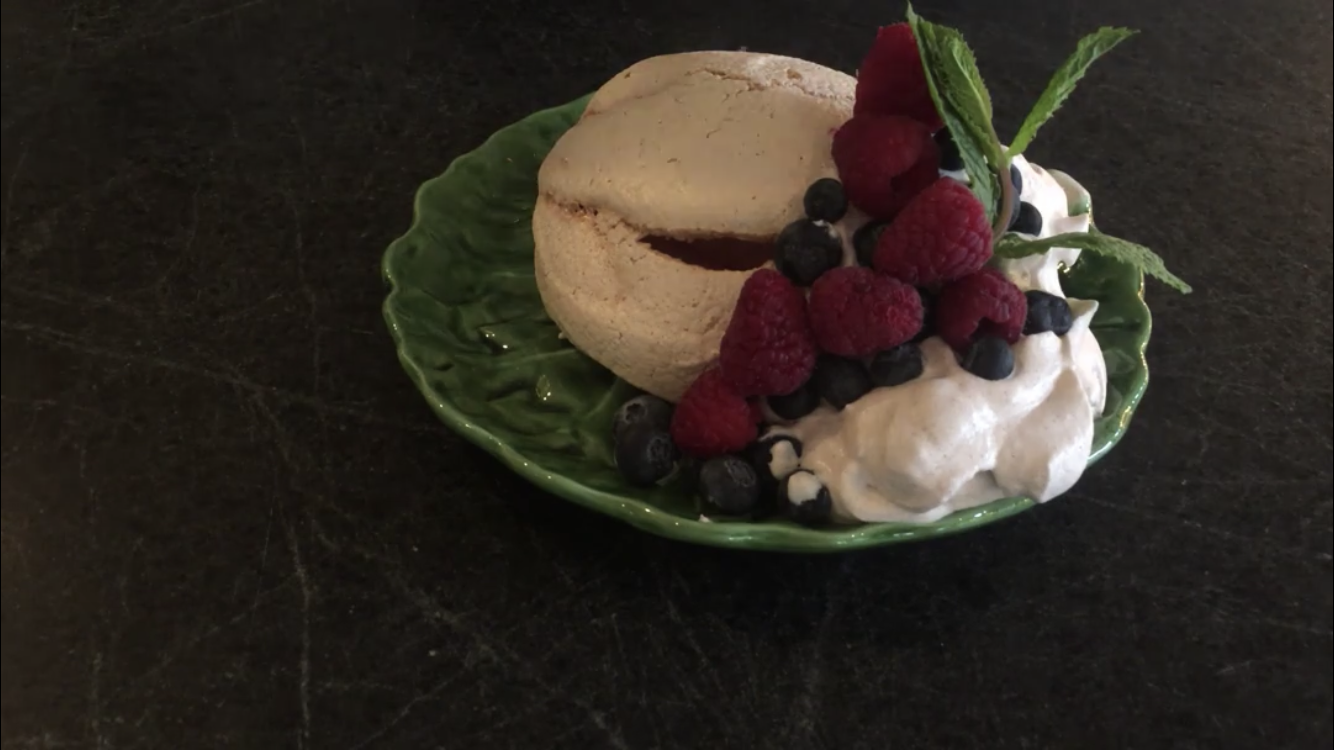Bake a pavlova
Make and bake a fruit topped pavlova by whisking egg whites, sugar, and cream; decorate with fresh fruit, with adult supervision for oven use.



Step-by-step guide to bake a pavlova
Step 1
Gather all the materials and put them on the counter so everything is easy to reach.
Step 2
Ask an adult to help and then separate 4 egg whites into the mixing bowl making sure no yolk gets in.
Step 3
Whisk the egg whites on medium speed until soft peaks form and the whites look cloudy.
Step 4
Add about 200 g caster sugar one tablespoon at a time while continuing to whisk until the meringue is glossy and forms stiff peaks.
Step 5
Sprinkle 1 teaspoon cornflour over the meringue.
Step 6
Add 1 teaspoon white vinegar (or lemon juice) and 1 teaspoon vanilla extract into the meringue.
Step 7
Gently fold the cornflour vinegar and vanilla into the meringue with a spatula until just combined.
Step 8
Spoon the meringue onto baking parchment on the tray and shape it into a round with a slight well in the center.
Step 9
Ask an adult to preheat the oven to 120°C (250°F).
Step 10
Ask an adult to put the pavlova in the oven and bake it for 1 hour.
Step 11
Ask an adult to turn the oven off and leave the pavlova inside to cool for 1 hour with the oven door closed.
Step 12
Whip about 300 ml heavy cream until soft peaks form for the topping.
Step 13
With adult help remove the cooled pavlova from the oven and place it on a serving plate.
Step 14
Spread the whipped cream in the pavlova well and decorate the top with fresh fruit.
Step 15
Take a photo and share your finished fruit-topped pavlova on DIY.org.
Final steps
You're almost there! Complete all the steps, bring your creation to life, post it, and conquer the challenge!


Help!?
What can we use instead of caster sugar, cornflour, white vinegar, heavy cream, baking parchment, or egg whites if those are hard to find?
Use superfine or blitzed granulated sugar for the 200 g caster sugar, cornstarch for the 1 teaspoon cornflour, lemon juice for the 1 teaspoon white vinegar, whipping or double cream for the 300 ml heavy cream, a silicone baking mat instead of baking parchment, and aquafaba (chickpea brine) as a vegan substitute for the 4 egg whites.
My meringue won’t get glossy or stiff—what likely went wrong and how can I fix it?
If the meringue won’t reach glossy stiff peaks, make sure no yolk or water got into the separated egg whites, use a clean dry metal bowl and whisk, add the 200 g caster sugar one tablespoon at a time while whisking on medium, and keep beating until the mixture is shiny before folding in the cornflour, vinegar and vanilla.
How can I adapt this pavlova activity for different age groups so it’s safe and fun?
For ages 3–6 have children gather materials and spoon or decorate the whipped cream while an adult separates eggs and handles the oven, for 7–12 let them whisk the egg whites and fold in ingredients with supervision, and for 13+ let teens operate the mixer, shape the pavlova on the baking parchment, and help with baking under adult oversight.
What are simple ways to extend or personalize the pavlova once the basic recipe is done?
Personalize the pavlova by folding a tablespoon of cocoa or citrus zest into the meringue before spooning onto the baking parchment, flavoring the 300 ml whipped cream with passionfruit pulp or a little icing sugar and vanilla, making mini pavlovas instead of one round, or decorating each finished pavlova with different fresh fruits before photographing for DIY.org.
Watch videos on how to bake a pavlova
Easy Pavlova Recipe | How to Make Pavlova at Home
Facts about baking for kids
🥝 Bright fruits like kiwi, strawberries, and passionfruit are popular pavlova toppings because they add color and tangy contrast to the sweet meringue.
🥚 Meringue is mostly whipped egg whites and sugar; the sugar helps stabilize the foam so it holds its shape.
🔥 Pavlovas are baked slowly at low temperature and often cooled in the oven to keep a crisp shell and soft, marshmallow-like center.
🩰 The pavlova was named after Russian ballerina Anna Pavlova — Australia and New Zealand both claim its invention in the 1920s.
🌀 Whisking traps tiny air bubbles in egg whites — faster whisking makes a fluffier meringue (electric mixers make it quicker!).
How do I make and bake a fruit-topped pavlova with my child?
What materials and ingredients do I need to bake a pavlova with kids?
What ages is baking a pavlova suitable for with kids?
What safety tips and variations should I know when making pavlova with children?


One subscription, many ways to play and learn.
Only $6.99 after trial. No credit card required



